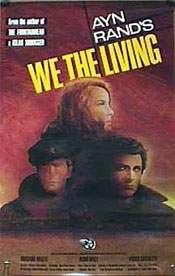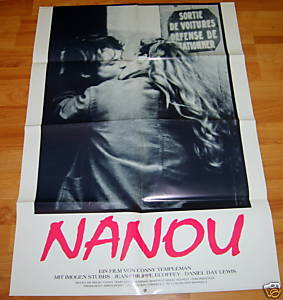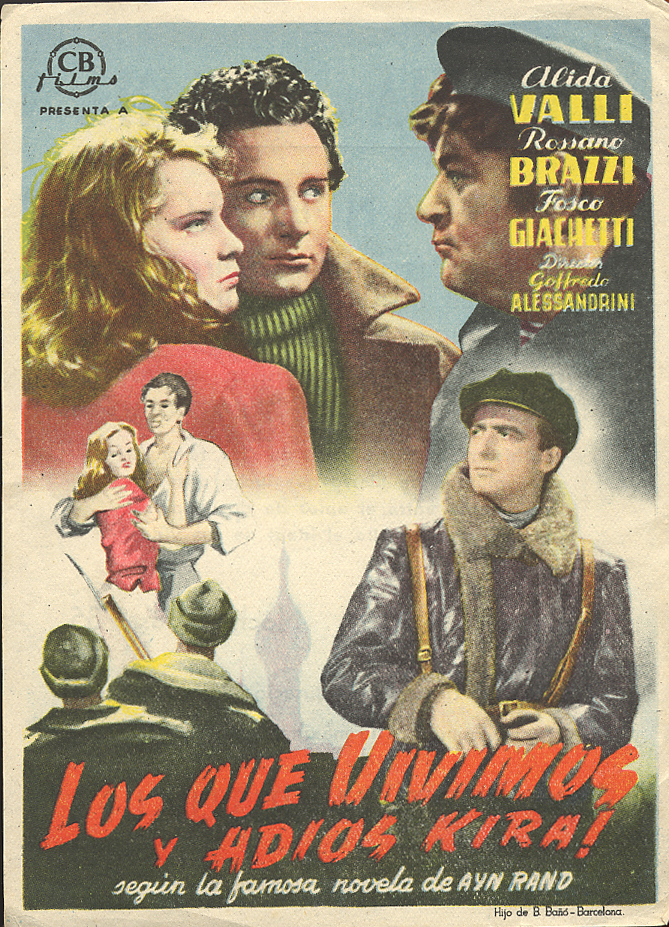From the Chicago Reader (January 27, 1989). — J.R.
NANOU
** (Worth seeing)
Directed and written by Conny Templeman
With Imogen Stubbs, Jean-Philippe Ecoffey, Christophe Lidon, Valentine Pelka, Roger Ibanez, Daniel Day Lewis, and Lou Castel.
WE THE LIVING
*** (A must-see)
Directed by Goffredo Alessandrini
Written by Anton Giulio Majano
With Alida Valli, Rossano Brazzi, Fosco Giachetti, Emilio Cigoli, Cesarina Gheraldi, Giovanni Grasso, and Guglielmo Sinaz.
There’s obviously a world of difference between Nanou, a low-budget Anglo-French coproduction of 1986, playing this week at the Film Center, and We the Living, a big-budget Italian movie of 1942, adapted from Ayn Rand’s first novel, playing this week at Facets Multimedia. But in certain areas they have an interesting relationship to one another. Both films come to us filtered through diverse national contexts, and both are love stories in which intense political commitment plays a substantial role — a role that is erotic as well as ideological and ethical in its implications. Where they differ most strikingly is in their underlying political assumptions, and in the way their narratives relate to those assumptions.
Nanou, shot entirely on locations in France and Switzerland and utilizing mainly French dialogue, is nonetheless an English film, in style as well as overall conception. A first feature by a recent graduate of London’s National Film and Television School, it follows the romance between a young English woman named Nanou (Imogen Stubbs), vacationing on the continent before she enters photography school, and a young French radical named Luc (Jean-Philippe Ecoffey), whom she meets and winds up living with for a spell in a small town in Lorraine.
Nanou gives up most of her identity for the sake of remaining with Luc, and while she helps him provisionally with his underground activities, mainly by taking photographs, he keeps her in the dark about the specifics of what he does, which is political agitation over massive factory layoffs in the area. Because the story is told from Nanou’s viewpoint, we’re as much in the dark as she is, though we are offered certain clues. One reason she has to stay put is that early on Luc takes her passport so that it can be falsified for an Italian radical he is helping to hide. (When she discovers what Luc has done, her symbolic form of protest is to walk ahead of him on the road, progressively discarding each item of her clothing, which she asserts now belong to him.)
Late in the film, Nanou accompanies Luc and his fellow activists on a trip to derail a train. Lagging behind the others after the explosion, she’s nearly discovered in the woods by a dog, and later she learns that Luc returned to the spot in order to kill the dog. Soon afterward she leaves Luc for good; while the killing of the dog isn’t her only reason — her dissatisfaction with him has become evident — it seems to work as a catalyst.
From a liberal standpoint, Nanou is “politically correct” — feminist, humanist, and populist in its strictly realist assumptions — and its eroticism has a great deal to do with the lure of Luc’s political life-style for Nanou, as well as her own impulses as a free spirit, which eventually come into conflict with that life-style. The main political conflict that the film appears to be dealing with is the conflict between Luc’s brand of underground terrorism and Nanou’s need to assert and affirm her own identity. The implication is that if she remained with Luc, she would eventually turn into a typical French housewife, in spite of Luc’s professed disdain for bourgeois comforts. But the film’s approach to this issue is elliptical and open-ended rather than didactic. While virtually everything we know about Luc is restricted to Nanou’s viewpoint, what we know about Nanou’s identity in England is equally circumscribed.
Hints are provided by separate brief visits from Nanou’s parents and from her friend Max (Daniel Day Lewis), but these sequences are designed to be suggestive rather than expositional. Max’s visit, in particular, raises almost as many questions as it answers; it is implied rather than established that Max is a former lover, and the presence in the role of Max of Lewis — the talented actor familiar from My Beautiful Laundrette and The Unbearable Lightness of Being — makes this episode register like a self-conscious cameo, almost as if Lewis were arriving from another movie to make a guest-star appearance in this one.
Conny Templeman’s open-ended realist approach to her story leaves the audience free to arrive at its own conclusions about the characters. It is quite the reverse of Ayn Rand’s method, which makes every dramatic moment didactic at the same time and spells out every meaning in glitzy neon. Yet paradoxically it is Rand’s story rather than Templeman’s that assumes a greater degree of ambiguity and complexity on-screen.
We the Living, an unauthorized Italian adaptation of Rand’s first novel, set in the 20s in postrevolutionary Russia, was initially a two-part film that ran for about four hours. Made in 1942, it became a smash hit but was suppressed by the Mussolini government five months after its release, partially at the urging of Nazi officials who felt that it was subversively anti-Fascist as well as anti-Communist. Rand herself purchased the original negative in 1968 and reedited it shortly before her death. In its present form, it runs for about 170 minutes; the original ending (of the film as well as the novel) has been scrapped, many subplots have been eliminated (although the continuity problems arising from this are relatively minor), and one climactic scene has been redubbed.
Unabashedly rhetorical and overblown, like all of Rand’s superromantic fantasies, We the Living intermittently suggests Gone With the Wind in its epic sweep and larger-than-life characters as well as its protracted running time, with postrevolutionary Russia figuring in and around its romantic triangle and network of intrigues much as the postbellum south figures in the Hollywood movie.
Kira Argounova (Alida Valli), the rabid counterrevolutionary heroine of We the Living, may be less morally ambiguous than Scarlett O’Hara, but the two men in her life — counterrevolutionary Leo Kovalensky (Rossano Brazzi), whom she loves, and Party official Andrei Taganov (Fosco Giachetti), who loves her and whom she exploits — are every bit as ambiguous and multilayered as Ashley Wilkes and Rhett Butler, even as stock figures.
Kira returns to Petrograd from abroad to study engineering and is appalled by the devastation of her bourgeois family at the hands of the new revolutionary order. Shortly after her return, she meets Leo, a fugitive from the police. Assuming she’s a prostitute, Leo propositions her, and she spontaneously accepts; but instead of proceeding to a hotel, they wind up in an abandoned garden that is enveloped in atmospheric fog. They immediately fall in love, and in dreamy close-ups reeking of both 40s Hollywood and French poetic realism, they reveal their true identities.
Kira and Leo later unsuccessfully attempt to flee from Russia, and much later wind up living together and studying at the technological institute, where Kira dreams of building bridges and skyscrapers. (At this point in the plot, if memory serves, Kira has been rejected by her family because of her relationship to Leo, and Leo has been unable to hold a job because of his aristocratic background.) Kira befriends Andrei Taganov, an idealistic Party official, who is unaware of the full extent of her relationship with Leo. Despite extreme ideological differences, Kira and Andrei share mutual respect. Then both Kira and Leo are expelled from the technological institute because of their upper-class backgrounds; Leo is dejected but Kira is defiant (“We’ll fight it, Leo. The country — the century — all of it”). When Leo contracts tuberculosis and she can’t get him admitted to a state institution, she calls on Andrei. Before she can tell him her problem, he confesses his love for her. Realizing that help from Andrei is the only way she can get Leo into a private sanatorium, she pretends to be in love with him and becomes his mistress; meanwhile she pretends to Leo that the money for his care is coming from a wealthy uncle.
According to Barbara Branden’s fascinating biography, The Passion of Ayn Rand, Rand was a staunch “anti-feminist” who “regarded man as a superior value” even before adolescence, and who later went so far as to define femininity as “hero-worship.” We the Living, which Rand wrote in English while running the wardrobe department at RKO during the early 30s, presumably obeys this erotically delirious dictum much as The Fountainhead did in the early 40s; I haven’t read We the Living, but the movie — which is said to be unusually faithful to both the spirit and the letter of the original, apart from the ending — certainly bears this attitude out. In more ways than one, for much of the film, Kira’s feminine identity is her worship of Leo.
Yet surprisingly, it is Andrei rather than Leo who emerges as the more heroic character, and Kira herself who remains the strongest member of the trio throughout. The exaltation of heroes and heroines may remind one of Leni Riefenstahl’s The Blue Light, Triumph of the Will, and Olympia, along with the fascist aesthetics that inform the monumentalism and luminosity of those films, but the personalities of these characters are a good deal denser than any of those (including Hitler) to be found in Riefenstahl’s films.
Leo, for example, is a romantic figure who is eventually corrupted and winds up as a decadent rake and gigolo. (Played by the young Rossano Brazzi, who occasionally suggests the young Cornel Wilde, he ultimately registers as an Adonis gone to rot.) Noble Andrei, caught between his Communist ideals and his love for Kira, winds up sacrificing himself to ensure her freedom. And while Kira isn’t shot trying to cross the border, as she was in the novel, her departure at the end conveys the same anti-Soviet message. All three characters are ultimately victimized by the Soviet state, but the degree to which the self-sacrifices of Kira and Andrei ennoble them complicates the emotional texture of Rand’s passionate belief in self-interest. Indeed the unwavering strength of Kira throughout the film implies a feminism that Nanou never even hints at.
As propaganda, We the Living signified a protest against Fascist Italy as well as Communist Russia when it was originally shown at the Venice Film Festival (to a cheering ovation). But it must also be acknowledged that the star positioning of the three leading actors, which is exploited to the utmost, has more general fascist implications of its own — the appeal of gods and goddesses, superhumans whose lives, ideals, and passions are more vital than our own. (Mussolini, who invented the film festival, certainly knew what star politics were all about.)
It is also worth pointing out that Rand’s redubbing of Andrei’s climactic speech to his superiors at a tribunal, a speech denouncing the Soviet state, was designed to bring the film’s message closer to her own. In the original film version, Rand was appalled to discover, Andrei reportedly said something like, “You sold out — you wanted the servitude of the Russian people to the foreign capitalists.” Rand’s hatred for the Soviet state, which she experienced firsthand as a bourgeois child (with, incidentally, the name Alice Rosenbaum), led to the extreme individualist and anticollectivist stance that characterized her philosophy of self-interest, including an admiration for such writers as Mickey Spillane. The polemical stance of the original film of We the Living was apparently a bit less singleminded about its priorities.
In the final analysis, We the Living comes across as a better movie than Nanou because its ideological assumptions, whether or not one agrees with them, are much easier to read and respond to. The relative realism and objectivity of Nanou leads to a certain murkiness of tone, intention, and character motivation; in the process of respecting her audience, Templeman may finally be leaving it a little too much out in the cold. By contrast, We the Living may frequently border on camp, but it’s still a whale of a show. Director Goffredo Alessandrini — a commercial Italian veteran who worked in Hollywood in the early 30s (and subsequently married Anna Magnani) — delivers the high-priced goods with style and appropriate mannerist hyperbole (including unnecessary fancy matching cuts to bridge scenes). Most of the secondary characters are defined with Dickensian gusto, and the 170 minutes tend to slide by with effortless grace.







